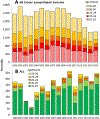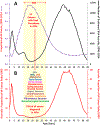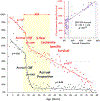Role of clinical trials in survival progress of American adolescents and young adults with cancer-and lack thereof
- PMID: 29667766
- PMCID: PMC6077840
- DOI: 10.1002/pbc.27074
Role of clinical trials in survival progress of American adolescents and young adults with cancer-and lack thereof
Abstract
In the United States, adolescent and young adult (AYA) patients with cancer have the lowest clinical trial participation rate of all age groups and slower progress in survival improvement than younger patients. Ominously, AYA clinical trial participation has been steadily decreasing since 2010, except in 15-19 year olds and AYAs with acute lymphoblastic leukemia. In order to reverse the accrual trend, multiple changes are necessary, including convincing community oncologists to pursue clinical trials on behalf of their AYA patients and to have the new National Community Oncology Research Program and National Clinical Trials Network lead a coordinated effort to increase accrual.
Keywords: adolescents and young adults; clinical trials; survival progress.
© 2018 Wiley Periodicals, Inc.
Conflict of interest statement
CONFLICT OF INTEREST
None of the authors are aware of any conflict of interest, potential or current, with the information in this report or its purpose.
Figures




References
-
- Bleyer A, Budd T, Montello M. Adolescents and young adults with cancer: the scope of the problem and criticality of clinical trials. Cancer. 2006;107:1645–1655. - PubMed
-
- Bleyer A, Barr R, Hayes-Lattin B, Thomas D, Ellis C, Anderson B. The distinctive biology of cancer in adolescents and young adults. Nat. Rev. Cancer 2008;8:288–298. - PubMed
-
- Surveillance, Epidemiology, and End Results (SEER) Program (www.seer.cancer.gov) SEER*Stat Database:Incidence—SEER 9, 13 and 18 Regions Research Data, Nov 2016 Sub (1973–2014) <Katrina/Rita Population Adjustment>-Linked to County Attributes-Total U.S., 1969–2015 Counties, National Cancer Institute, DCCPS, Surveillance Research Program, Surveillance Systems Branch, released April 2017, based on the November 2016 submission.
-
- Surveillance, Epidemiology, and End Results (SEER) Program (www.seer.cancer.gov) SEER*Stat Database: Mortality—All COD, Aggregated With State, Total U.S (1969–2014) <Katrina/Rita Population Adjustment>, National Cancer Institute, DCCPS, Surveillance Research Program, Surveillance Systems Branch, released December 2016.
-
- National Intercensal Estimates (2000–2010). https://www2.census.gov/programs-surveys/popest/tables/2000-2010/interce.... Accessed January 28,2016.
MeSH terms
Grants and funding
LinkOut - more resources
Full Text Sources
Other Literature Sources
Medical

